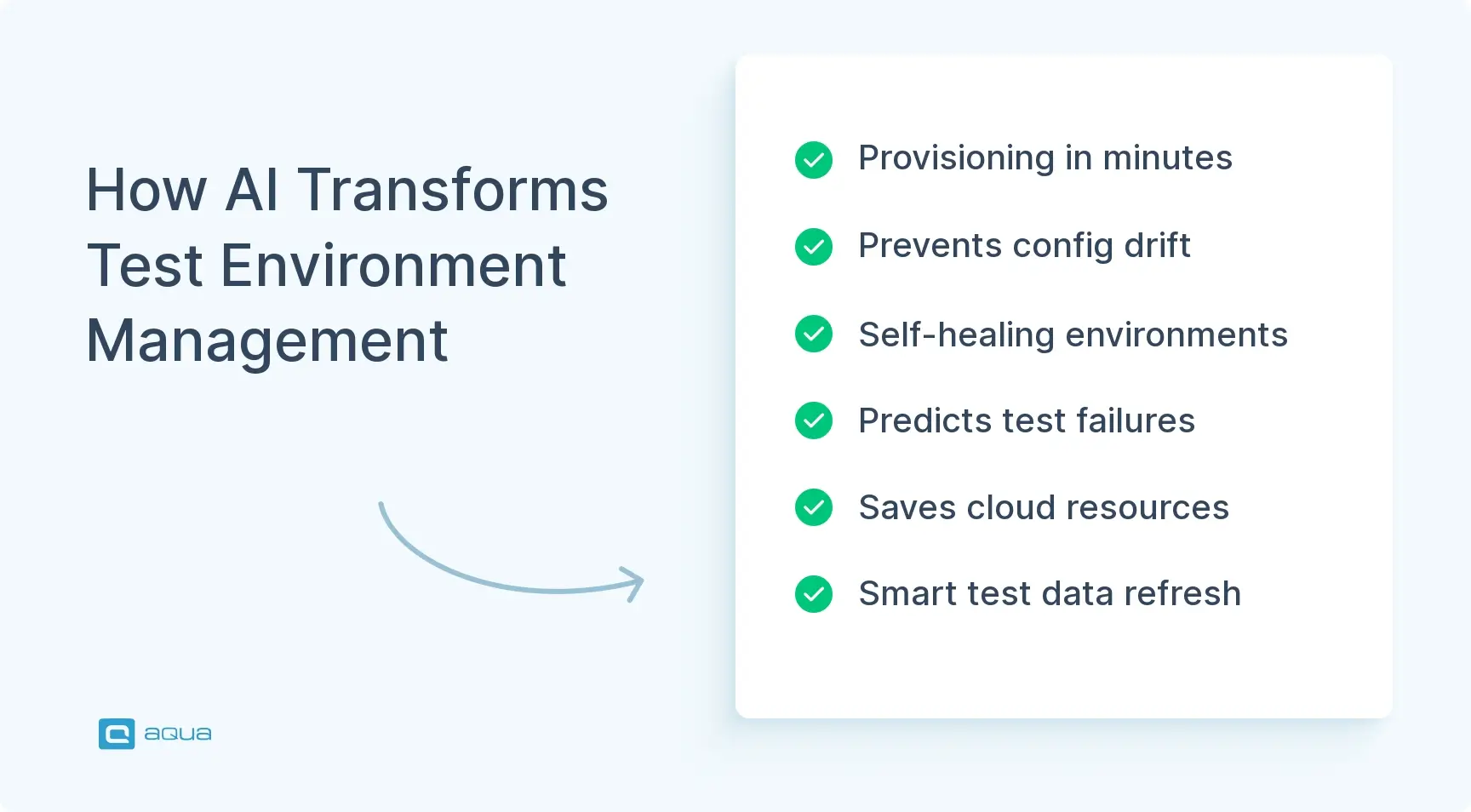Key Takeaways
- AI-driven test environment management automates provisioning, reduces setup time from days to minutes, and prevents configuration drift through self-healing capabilities.
- Traditional test environment management remains largely manual, with organizations spending up to 30% of testing time troubleshooting environment issues rather than actual application defects.
- AI systems can predict potential environment problems by analyzing historical data about usage patterns, test results, and failure patterns before they impact testing.
- Implementing AI for test environment management requires quality data collection, phased implementation, and clear balance between automation and human control.
- Future AI developments include autonomous self-managing environments, generative AI for natural language requests, and digital twins that provide synchronized virtual replicas of production systems.
Looking for ways to eliminate testing bottlenecks while improving software quality? AI-powered test environment management might be the breakthrough solution your team needs. Discover the implementation roadmap and real-world benefits in the complete guide below 👇
What is Test Environment Management?
You probably already know what test environment management is. You live it every day.
Test environment management covers provisioning, configuration, maintenance, and teardown of your testing infrastructure. Servers, databases, middleware, applications, and test data. Everything needs to mirror production closely enough for valid results while staying isolated enough for safe testing.
The basics haven’t changed. Environments still need scheduling so teams don’t collide. Configurations still need updates when dependencies change. Monitoring still matters. Test data still needs refreshing. Someone still has to coordinate between dev teams running integration tests, QA running regression suites, and release managers prepping deployments.
When your TEM works well, testing flows. When it breaks down, everything stops. Environments go missing, configurations drift, and data goes stale. Your team wastes hours chasing environment issues instead of finding real bugs.
Some organizations still manage environments manually. Provisioning by hand. Copying and pasting configs. Updating settings one at a time. Reacting to fires instead of preventing them.
You should know this approach doesn’t scale. Not with the release velocity your organization demands.
Let’s look at the challenges in more detail.
Challenges in Traditional Test Environment Management
You’ll face different challenges while trying to manage your test environments traditionally. You have to know why they arise, and what can fix them.
Manual Provisioning Takes Forever
Setting up a complex test environment takes way longer than it should. Multiple servers, databases, network configs, and application dependencies all need setup by hand. Your team installs software, tweaks settings, and troubleshoots why server A won’t talk to database B. Days pass before anyone runs a single test. Meanwhile, the sprint clock keeps ticking, and stakeholders keep asking when QA will be ready.
Configuration Drift Turns Environments Into Mysteries
Environments start clean and documented. Then someone makes one quick change to fix a blocking issue. Someone else tweaks a timeout value. A third person updates a library version. Nobody writes it down because everyone’s busy, and it’s just one small thing. Fast forward two weeks, and your environments are different, none of them matching what’s documented. Tests pass in staging, fail in QA, and pass again in pre-prod. Your job changes from finding bugs to something else. You’re playing detective, trying to figure out which environment is lying to you.
"It Works On My Machine" Never Gets Old (Except It Does)
This phrase stops being funny around the third time you hear it in standup. When tests behave differently across environments, you lose trust in your results. Research shows teams waste up to 30% of testing time troubleshooting environment issues instead of finding real application defects. That’s nearly a third of your capacity spent fixing the testing infrastructure rather than testing the actual software.
Test Data Is A Puzzle With Missing Pieces
You need test data that looks real enough to surface actual issues. You also need it to be clean of anything that could violate privacy regulations. Striking that balance isn’t straightforward. When using production data, you risk compliance problems. Using synthetic data can lead to you missing edge cases that only real user behavior reveals. Most teams end up picking their poison and hoping for the best.
Resource Conflicts Create Bottlenecks
When multiple teams need the same environment, someone ends up waiting. The performance testing environment might be occupied. The staging environment could be locked for a critical test run. Without clear visibility into who’s using what and when they’ll be done, teams either sit idle or risk interfering with each other’s work. Both options slow things down.
Environments Run When Nobody's Using Them
Environments often keep running long after the work is done. That staging environment from yesterday’s regression suite might still be up, consuming resources and budget. When teams move on to the next task, shutting down unused environments rarely makes it to the top of anyone’s list. This leads to costs adding up across dozens of forgotten environments.
Dependencies Break In Creative New Ways
Modern applications often rely on multiple services, each with its own release schedule. Update one service in your test environment, and integration tests might start failing. Figuring out which versions work together becomes its own puzzle, especially when those dependencies keep evolving.
Environment Refreshes Move At A Glacial Pace
Getting test environments updated with the latest builds, configs, and data takes time. Sometimes it happens overnight. Other times it stretches into days, especially when something breaks during the refresh process and needs manual intervention to get back on track.
These problems hit hardest when you’re trying to move fast. Your CI/CD pipeline is smooth. Code flows through builds and deployments beautifully. Then it reaches test environment management and everything grinds down. The manual bottleneck erases the speed gains you worked hard to build everywhere else.
Good news? This is exactly what AI solves.
You need teams collaborating. A way to test integration without needing an entire environment would be to do contract testing. That way, you can easily run the tests in CI or on local machines. But it still needs collaboration on the tests between both developers of the consumer and producer side.
How AI Enhances Test Environment Management
AI tackles the exact problems we just walked through. It’s not magic. They do it with machine learning and predictive analytics that handle the grunt work your team shouldn’t be doing manually anymore.
Automated Provisioning That Actually Thinks
AI-driven test environment management goes beyond basic automation scripts. It looks at your application requirements and provisions the right environment with all dependencies included. More importantly, it learns from historical patterns. Performance tests need beefier resources than functional tests. AI adjusts configurations based on what actually works, not what someone hardcoded six months ago.
What used to take days now happens in minutes. The system remembers past deployments, anticipates what you’ll need, and catches potential issues before provisioning even starts.
Self-Healing Environments That Fix Themselves
Environments drift. Services crash. Configurations change. AI monitoring catches these problems as they happen and fixes them without waiting for someone to notice. A service goes down? It restarts. A configuration drifts? It gets rolled back. Resources get tight? They get reallocated.
Your tests keep running instead of failing because of infrastructure hiccups. The environment fixes itself while your team focuses on actual testing work.
Predictive Analytics That Spot Problems Early
AI analyzes patterns across environment usage, test results, and failures. It notices that a specific database configuration always chokes during load testing. Or that certain dependency combinations lead to integration test failures. You get warnings before problems tank your test runs, not after.
This is where AI proves its value. It finds the problems you wouldn’t spot until they’ve already cost you time.
Smarter Test Data Management
Automated test data management gets a major upgrade with AI. The system generates synthetic data that behaves like production data without exposing anything sensitive. It understands relationships between data entities, so your test datasets actually reflect real-world scenarios instead of just looking like they do.
AI also optimizes when and how data refreshes happen. Fresh data when you need it, without wasting resources refreshing data nobody’s using. It is one of the main perks of automated test environment management.
Resource Optimization That Saves Money
AI watches how your environments get used and adjusts resources in real time. Heavy testing load? Resources scale up. Environment sitting idle? It hibernates or shuts down. No more paying for servers that aren’t doing anything, and no more tests delayed because resources weren’t available.
Cloud costs drop. Testing speed stays consistent. Resources go where they’re actually needed.
Visibility That Actually Helps
AI-powered dashboards show you what matters, not just what’s measurable. Instead of drowning in metrics, you get insights about where bottlenecks are forming, which environments are underused, and where your infrastructure needs attention.
The monitoring tells you what to do, not just what’s happening.

Why This Matters For Your Testing Stack
These capabilities add up to faster, more reliable testing infrastructure. But AI doesn’t work in isolation. The real power comes when AI-driven test management tools integrate environment management with your broader testing workflow. You need a system that connects automated provisioning, intelligent test execution, and environment optimization into one coherent platform. That’s where modern test management systems come in.
aqua cloud handles test environment management through customizable environments, environment-specific workflows, and direct integrations with Jira, Jenkins, and other platforms via REST API. Environment status syncs automatically, and tests trigger in specific environments without manual work. The domain-trained AI Copilot automates test case creation and generates test data at scale, including edge cases that manual approaches typically miss, while learning from your project documentation to deliver relevant, environment-aware testing assets. aqua keeps all your testing activities organized and connected in one place, with complete traceability across requirements, tests, and environments. When your testing workflow is centralized and intelligently managed, environment configuration stops being a bottleneck.
Transform your test environment management with a 100% AI-powered TMS
Applications of AI in Test Environment Management
Now that you know what AI does, here’s where it actually gets used in your testing workflow.
Continuous Integration and Delivery Pipelines
Your pipeline runs dozens or hundreds of times per day. Each run needs the right environment configuration, and AI makes that decision based on the code changes coming through. A frontend fix gets a different environment than a database schema update. The provisioning happens in line with your build process, tests execute in the right context, and cleanup happens automatically when the pipeline completes.
This matters because your pipeline is only as fast as its slowest part. Manual environment setup used to be the slowest part. Not anymore.
Load and Stress Testing at Scale
Performance testing needs environments that behave like production under real user loads. AI configures these environments by studying actual traffic patterns from your monitoring data. Peak shopping hours for an e-commerce site look different than steady state usage. Financial quarter end looks different than mid-month activity.
AI also manages the infrastructure during test execution. As the load increases, it monitors for saturation points and adjusts the test environment’s capacity to keep tests running without false failures from infrastructure limits. You find application bottlenecks, not testing infrastructure bottlenecks.
Security and Penetration Testing Scenarios
Security testing requires specific environment states that simulate vulnerabilities or attack conditions. AI builds these scenarios by configuring environments with particular versions, settings, or network topologies that match known threat models.
Do you need to test how your application handles SQL injection attempts? AI configures a test environment with appropriate database exposure. Testing API rate limiting? It sets up the network conditions and monitoring to validate your defenses work as designed.
Cross Platform and Cross Browser Testing
Applications run on combinations of operating systems, browsers, devices, and screen sizes. Testing all combinations would require massive infrastructure. AI determines which combinations actually matter based on your user analytics and industry usage patterns.
It provisions the specific configurations needed, runs tests in parallel where possible, and identifies when results from one configuration can reasonably predict results in similar configurations. You get coverage without testing every possible permutation.
Blue Green and Canary Deployment Testing
Before production rollouts, teams often use staged deployment strategies. AI manages the test environments for these approaches by maintaining parallel environments with different application versions, routing appropriate test traffic to each, and monitoring for divergent behavior.
Compliance and Regulatory Testing
Industries with strict compliance requirements need test environments in software testing that replicate regulatory scenarios. AI configures environments that match specific compliance frameworks, whether that’s HIPAA for healthcare, PCI DSS for payment processing, or GDPR for data privacy.
These environments include appropriate data masking, access controls, audit logging, and monitoring that mirrors production compliance requirements. Your compliance testing actually tests compliance controls, not just functionality.
Each of these applications solves a specific problem in your testing workflow. The value isn’t in having AI manage environments generally. It’s in having it handle the specific, repetitive, error-prone tasks that slow down each type of testing you need to do.
How to Implement AI-Driven Test Environment Management
Moving to AI-driven test environment management takes planning and happens in stages. Here’s how to approach it.
Start With What You Actually Have
Map your current environment setup. Document how long provisioning takes, where bottlenecks happen, which configurations cause the most problems, and how resources get used. You need numbers before you can improve them.
Identify what matters most to your organization. Faster provisioning? More stable environments? Better resource usage? Smarter test data handling? Pick your priorities because you can’t fix everything at once.
Collect the Data AI Needs to Learn
AI works on patterns, and patterns come from data. Set up logging and monitoring across your test environments to capture configuration details, resource usage, test execution results, failures and incidents, and usage patterns over time.
Give this enough time to collect meaningful data. A few days won’t cut it. You need weeks or months to capture different scenarios, peak usage periods, and the variety of problems that actually occur.
Pick Your Technology
Choose tools that fit your existing infrastructure. Look at how they integrate with your CI/CD pipeline, whether they support your cloud providers and virtualization platforms, if they scale to handle your environment volume, what security features protect your testing data, and how complex implementation and maintenance will be.
Top Test Environment Management Tools
Plutora focuses on release and environment coordination for enterprise teams managing complex infrastructure. It provides visibility across environments and helps coordinate releases when multiple teams share limited testing resources. Works well for large organizations with complicated deployment schedules.
Enov8 offers environment and test data management combined in one platform. It handles provisioning, tracking environment usage, and managing test data across different environments. Good fit for teams that need both environment control and data management capabilities.
Quali CloudShell automates environment provisioning using infrastructure as code. It spins up on-demand testing environments in cloud and on-premises infrastructure with self-service access for development teams. Best for teams heavily invested in cloud infrastructure who need quick environment creation.
aqua cloudmanages all your testing activities in one organized, connected platform. It integrates with your existing tools like Jira, Jenkins, and Azure DevOps through REST API, syncing environment status automatically and triggering tests in specific environments without manual work. The AI Copilot automates test case creation and generates environment-aware test data at scale, learning from your project documentation to deliver relevant testing assets. While environment management is not the core value of aqua, the ability to manage and orchestrate every piece of your testing ecosystem is exactly what aqua brings to the table.
BMC Release Process Management integrates environment management into broader release processes. It coordinates environment availability with release schedules and handles conflicts when multiple releases need the same environments. Suited for enterprise IT teams managing formal release processes.
Purpose-built TEM tools with AI features usually get you results faster than building custom solutions from scratch. They come with the AI capabilities already configured, and you build expertise while using them. Some teams look at a test environment management tool open source for an AI-based solution as a starting point, but make sure any tool you evaluate actually delivers the AI capabilities you need, not just the basics.
Roll It Out in Phases
Don’t try to transform everything at once. Start small and expand as you learn what works.
Begin with automated provisioning for one application or team. Get that working smoothly. Add self-healing capabilities and better monitoring. Once those are stable, bring in predictive analytics and resource optimization. Then tackle advanced test data management. Finally, expand across all your applications and environments.
Each phase proves value and builds confidence before you move to the next. You also learn what works in your specific context, which helps you avoid mistakes when you scale up.
Train Your Team
Your team needs to understand what AI is doing and how to work with it. Technical staff need to learn basic AI concepts, how to use the specific tools you’re implementing, how to analyze data for optimization, and how to integrate AI with your infrastructure automation.
Stakeholders need different training. Focus on how to interpret AI recommendations, what the new dashboards and reports mean, and how to adjust processes to take advantage of AI capabilities.
Keep Improving
Set up regular reviews of your environment metrics. Compare them against your baseline to see what’s actually improving. Collect feedback from users about what’s working and what isn’t. Adjust AI parameters based on what you learn.
Make this a routine part of your process, not a one time setup. Weekly metric reviews and monthly tuning sessions keep your AI implementation getting better over time instead of stagnating.
This approach gets AI working in your environment management without disrupting everything at once. You prove value early, learn as you go, and build toward the full benefits incrementally.
What to Watch Out For When Implementing AI
AI solves real problems in test environment management, but implementation comes with its own challenges. Here’s what to expect and how to handle it.
Your Data Needs to Be Clean
AI learns from your data. Bad data means bad decisions. Inconsistent logs, incomplete metrics, or gaps in your historical records will produce unreliable automation and recommendations that don’t match reality.
Before you implement anything, check your data quality. Standardize how you log environment activity across teams. Make sure your telemetry captures what actually matters. Keep enough historical data to train models properly. If your logging is a mess, fix that first.
Integration Gets Complicated
AI for test environment management needs to talk to your infrastructure tools, CI/CD pipelines, monitoring platforms, and test management systems. Each integration brings challenges. APIs don’t match. Data formats differ. Security policies restrict data sharing. Legacy systems don’t play nice with modern tools.
Plan for this complexity. You might need middleware to bridge gaps between systems. You’ll definitely need a strategy for managing APIs and transforming data between different formats.
Decide What Gets Automated
Not every decision should be fully automated. Figure out which actions AI can handle independently, which should be recommendations that humans approve, and which stay entirely under manual control.
Resource scaling up to a threshold? Automate it. Tearing down production adjacent environments? Maybe require approval. The balance will shift as your team gets comfortable with what AI does well and where it makes mistakes.
Implementation Costs Money
AI reduces long-term costs, but getting there requires investment. Software licensing, infrastructure upgrades, training, and possibly consulting help. Build a business case that accounts for both spending and savings. Include hard numbers like reduced cloud costs and fewer delays, plus softer benefits like better quality and faster releases.
Start with high ROI use cases to prove value before expanding. Cloud-based solutions with usage-based pricing can lower upfront costs compared to building everything yourself.
People Resist Change
Moving to AI-driven environment management changes how your team works. Some people worry that their skills will become obsolete. Others don’t trust automated systems to make the right calls.
Address this directly. Explain that AI handles tedious manual work so your team can focus on test design, exploratory testing, and strategic decisions. Involve key people early in planning. Show quick wins to build confidence. Provide training on AI-related skills so people see career growth opportunities, not threats.
How do you help teams adapt?
Shift the conversation from task elimination to responsibility evolution. Environment managers stop manually configuring servers and start overseeing AI decisions, optimizing strategies, and solving problems AI can’t handle. It’s a move up, not out.
The Future of AI in Test Environment Management
AI in test environment management keeps evolving. Here’s where it’s headed and what that means for your testing workflow.
Environments That Manage Themselves
Future test environments won’t wait for provisioning requests. They’ll watch code changes, track sprint plans, learn from usage patterns, and configure themselves before anyone asks. Performance drops? The environment adjusts. Dependencies update? Configurations change automatically. Problems surface? They get fixed before tests fail.
You set policies and priorities. The environment handles everything else.
Natural Language Configuration
Describing what you need will replace navigating configuration tools. “Set up a load testing environment for the checkout service with Black Friday traffic patterns and production scale data.” The AI interprets that request, provisions infrastructure, configures components, and loads appropriate data.
This opens test environment management to team members without deep infrastructure knowledge. Less dependency on specialists. Faster environment access for everyone.
AI Agents That Coordinate Testing
AI test management tools are moving beyond following rules to making intelligent decisions across your testing ecosystem. These agents will analyze which features matter most to customers, allocate testing resources accordingly, and adjust strategies based on business impact rather than just technical requirements.
High engagement feature getting updated? The AI agent provisions more comprehensive test coverage automatically. Low priority maintenance work? Lighter testing with faster turnaround.
Digital Twins for Complex Systems
Virtual replicas of production environments will become standard for testing complex systems. These digital twins stay synchronized with production, let you test changes against realistic conditions without touching live systems, and use predictive analytics to surface potential problems before deployment.
Edge and IoT Testing at Scale
Applications running on thousands of edge devices need testing that accounts for variable connectivity, limited resources, and hardware differences. AI simulates these conditions at scale so you can validate behavior across diverse deployment scenarios without manually configuring each variation.
Business Focused Testing Decisions
Future AI connects test environment decisions to business outcomes, not just technical metrics. It understands how testing infrastructure affects quality, how quality affects customer satisfaction, and how satisfaction drives business results.
This helps you justify infrastructure investments and prioritize improvements based on actual business value, not just operational efficiency.
What This Means for Testing Teams
Your role shifts from managing infrastructure to designing quality strategy. Less time on environment setup and test execution. More time interpreting results, connecting quality initiatives to business goals, and working with AI to optimize testing approaches.
The automation handles routine work. You handle the strategic decisions that AI can’t make alone.
Test environment management is changing. aqua cloud handles the problems we’ve covered in this article with a unified testing platform built for how teams actually work. AI-powered test case generation saves teams over 12 hours per week. Environment-specific workflows keep your testing pipeline consistent. Migration tools sync test data between environments without manual transfers. Integrations like Jira, Confluence, Azure DevOps, and CI/CD frameworks like Ranorex, Jenkins, supercharge your toolkit for better environment management. aqua’s domain-trained AI Copilot learns from your project documentation, so the test cases and data it generates fit your actual context instead of applying generic templates. Manual bottlenecks in test environment management don’t have to slow you down anymore.
Reduce environment setup time by 97% while improving test quality with aqua's AI-powered platform
Conclusion
Test environment management has been a bottleneck for too long. AI fixes that by automating provisioning, catching problems before they break tests, optimizing resource usage, and spotting patterns that predict issues. Using these tools helps you see environment setup drop from days to minutes, cloud costs decrease, and fewer testing delays caused by infrastructure problems. More importantly, your testing becomes faster and more thorough, which means better software reaching customers sooner. The technology keeps improving, and teams using it now are pulling ahead of those still managing environments manually. If test environment management slows you down today, AI is worth exploring.

















